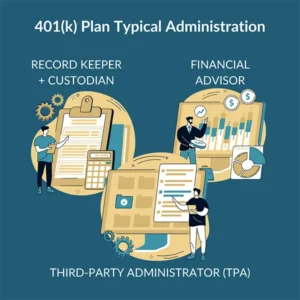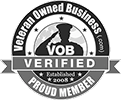Why Every Business Needs A 401(k) Plan:
Believe it or not, most small businesses don’t offer a 401(k) plan. A 401(k) plan is a powerful tool for promoting financial security in retirement, benefiting both employees and employers.
A 401(k) Retirement Plan Can
Help employers attract and keep talented employees.
Allow participants to the opportunity to grow their wealth.
Offer significant tax advantages - including deduction of employer contributions.
However, many 401(k) plans are also overpriced for employers, can have expensive and under-performing investment options, and tedious administrative provisions.
Why Are 401(k) Employer Plans Not Affordable?
Let’s examine how a small business 401(k) plan works to answer that.

Typically, there are three parties involved in a 401(k) plan:
The record keeper and custodian team are in charge of tracking assets in terms of how much belongs where, meaning how much of a participant’s balance is contributions vs. match, how much is pre-tax vs. Roth, etc. They usually charge around 0.25% to 0.50%, including about 0.10% for the custodian, which is the entity holding the assets. What they don’t do is keep track of employee eligibility, which is left to the employer.
A Third Party Administrator (or TPA) prepares documents and ensures the employer stays in compliance with the IRS and the Department of Labor. A critical task the TPA performs is preparing Form 5500; however, it is typically the employer’s responsibility to file it. TPA fees can be complex and include setup fees, support and maintenance fees, amendment fees, and, increasingly, termination fees, totaling approximately $3,000 to $5,000 annually. Suppose the TPA provides 3(16) fiduciary services, which includes filing Form 5500 on behalf of the employer. In that case, the total yearly expense can rise to $7,000 to $9,000.
Financial advisors are tasked with educating and providing investment advice for you and your employees. They are typically involved with investment selection, which is essential because these plans can have numerous mutual fund options. Many of these can have unreasonable internal expenses. A typical advisory fee will be around 1%.
Option 1:
Manually Establishing a 401(k) Plan
Several basic actions are required when starting a 401(k) plan. One of the initial decisions is whether to set up the plan independently or consult a professional or financial institution (such as a bank, mutual fund provider, or insurance company) to assist in its establishment and maintenance.
In addition, there are four critical steps for setting up a 401(k) plan:
Adopt a written plan document: This document forms the foundation for day-to-day plan operations. If you have hired assistance, they will likely provide this document.
Part of this process is choosing the type of plan best for you – a traditional 401(k) plan, a safe harbor 401(k) plan, or an automatic enrollment 401(k) plan. In all types, participants can contribute through salary deductions.
Arrange a trust for the plan’s assets: A plan’s assets must be held in trust to ensure that they are used exclusively for the benefit of participants and their beneficiaries. The trust must have at least one trustee responsible for managing contributions, investments, and distributions. Selecting a trustee is crucial for maintaining the plan’s financial integrity. It is one of the most important decisions in establishing a 401(k) plan.
Develop a recordkeeping system: A reliable recordkeeping system is crucial for tracking contributions, earnings, losses, investments, expenses, and benefit distributions. If a contract administrator or financial institution manages the plan, they usually assist with these records. This system is also necessary for preparing the annual return or report that must be filed with the federal government.
Provide plan information to eligible employees: You must notify employees who are eligible to participate in the plan about specific benefits, rights, and features. Additionally, a summary plan description (SPD) must be provided to all participants. The SPD serves as the primary source of information for participants and beneficiaries regarding the plan and its operation and is typically created alongside the plan document.
Option 2:
Trajan Wealth and 401Go
If you want to simplify and reduce the costs of a 401(k) plan for your small business, we have an effective solution. Our partner, 401Go, uses advanced technology to streamline administrative tasks, ensure compliance, and track eligibility. They prepare and file the 5500 forms, a service often not provided by other third-party administrators. By combining traditional roles into one platform, 401Go can cut expenses by up to 25%.
At Trajan Wealth, we can set up your company’s 401(k) plan for just $65 per month per plan and $8 per month per participant, along with a typical custodian fee of 0.10% and an advisory fee capped at 0.75%.* Tax credits are also available to help offset costs!
Setup can be done quickly, and with five or more employees, a 401(k) can help attract and retain top talent. If you’re an employee without a 401(k), encourage your boss to reach out to Trajan Wealth today!
*Fees subject to change. Services offered through a third-party partner.


